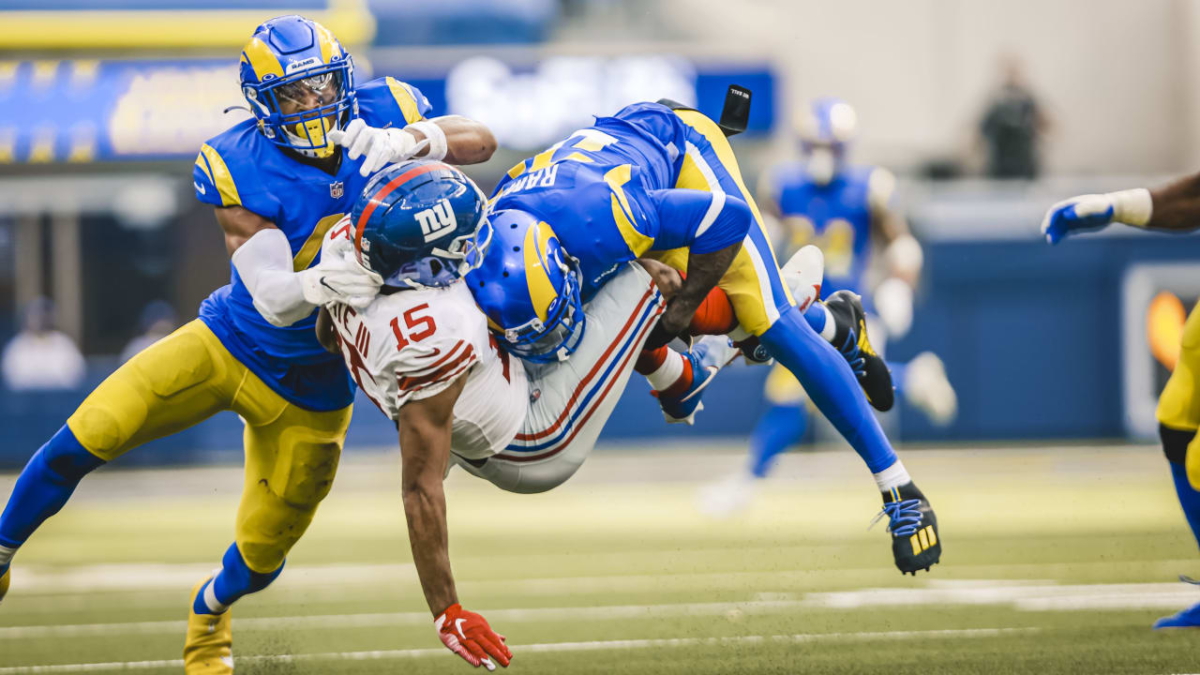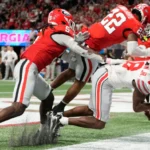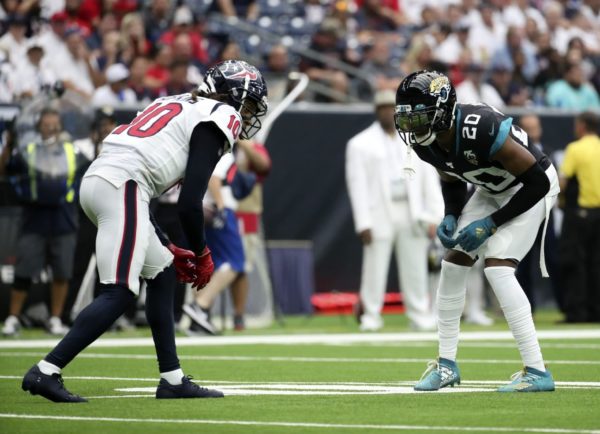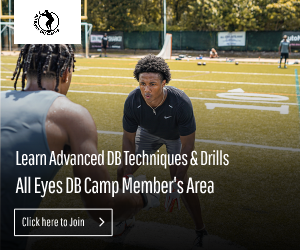By: Chad Wilson
IG: @alleyesdbcamp
Tackling is an essential skill for any defensive back in football. Whether you’re a cornerback, safety, or nickelback, your ability to bring down the ball carrier is critical for the success of your defense. With so many defenses opting to play in a bend but don’t break manner, there is even more pressure to make the tackle and not allow the big gain off of a short pass. In this article, we’ll explore techniques and strategies to help you improve your tackling as a defensive back, so you can be a more reliable and effective player on the field.
Proper Stance and Alignment
Tackling begins before you even make contact with the ball carrier. Ensure you start with the correct stance and alignment. Keep a low and balanced stance. Lower your hips, bend your knees, and keep your weight on the balls of your feet. This stance allows for quick reactions and better balance. You will need these things when the ball carrier starts making moves to avoid your tackle. Position yourself correctly relative to the ball carrier and your teammates. Maintain leverage and take the appropriate angle to make the tackle effectively.
Breakdown and Gather
Before making a tackle, it’s crucial to break down and gather yourself. This involves slowing down, maintaining balance, and preparing to make the tackle. When closing in on the ball carrier, slow down and take shorter, controlled steps. This gives you the ability to change direction or react to the ball carrier’s moves. Keep your shoulders square to the line of scrimmage and the ball carrier. This prevents the ball carrier from easily sidestepping your tackle attempt. Another major key is where your eyes are. Zero in your eyes on the ball carrier’s waist if he’s directly in front of you and on the near hip if he’s to the side of you. Don’t underestimate the power of your eyes in making a both an in line and open field tackle.
Wrap-Up Tackling
Wrap-up tackling is a fundamental technique that involves securing the ball carrier and bringing them to the ground. Aim for the ball carrier’s midsection or thighs. This is the most effective area to tackle, as it reduces the chance of missing the tackle or allowing additional yards after contact. After making contact, wrap your arms securely around the ball carrier. Squeeze tightly, using your chest and shoulders to add pressure. This restricts the ball carrier’s ability to break free. Use your legs to drive through the tackle. Lift with your hips and explode upward, taking the ball carrier off their feet and driving them backward. Too many defensive backs nowadays are looking for the big hit. Their aim is to try and knock the ball carrier off of their feet and draw a cheer from the crowd. You may achieve this objective occasionally but more times that not, you will bounce off of the ball carrier and embarrass yourself. Football players today do more work in the weight room and on their balance than in the past. The odds are against you when you go for this type of tackle. Wrap up and win.
Avoiding Tackle Breakers
In addition to mastering wrap-up tackling, it’s essential to minimize the ball carrier’s chances of breaking free. Keep your head up and to the side, not down. This prevents helmet-to-helmet collisions and minimizes the risk of injury. Maintain a low center of gravity and keep your hips down when making contact. This helps you gain leverage and prevents the ball carrier from running through the tackle. Don’t tackle in isolation. If possible, use the sideline, boundary, or your teammates to your advantage. Funnel the ball carrier toward help to make the tackle more effectively. It should also be your aim to make contact with your near leg and near shoulder on the ball carrier. This increases the power of your contact and gives you a better chance to execute the rest of the steps in the tackle. Stopping or reversing the momentum of the ball carrier is going to increase your chance of executing the tackle.
Recognition and Reaction
Tackling also involves recognizing the type of play, anticipating the ball carrier’s movements, and reacting quickly. Pay close attention to the play unfolding in front of you. Anticipate where the ball carrier is likely to go and prepare to make your move. Understand pursuit angles. Position yourself so that you can cut off the ball carrier’s path and limit their options. This is another aspect of tackling that often gets neglected. As a defensive back you will often find yourself approaching a ball carrier from the middle of the field as he is approaching or running near the sidelines. Many times, defenders face the ball carrier and look to meet them with their shoulders squared to the sidelines. This can open up the cut back lane for the ball carrier which means a missed tackle. Instead, squeeze the ball carrier to the sideline and shuffle towards him with your near shoulder approaching the sidelines. Do this as opposed to squaring your shoulders to the sidelines. This allows you to make a tackle if the ball carrier attempts to cut back to the open field.
Tackling Drills
Regular practice is essential to improve your tackling skills. Incorporate tackling drills into your training regimen to refine your technique, build confidence, and enhance your ability to tackle under pressure. Repetition works when it comes to improvement. There’s an old saying that goes “tackling has a lot to do with want to.” This gives off the suggestion that fear hinders the defender from making tackles. There is a hint of truth to that. However, learning the proper way to tackle along with perfecting the art of tackling, reverses that fear into intense desire. You turn into a player that wants to implement the tackling techniques to show how good you are at it and how much it works.
If tackling is an area where you struggle as a defensive back, it can’t be ignored. The truth of the matter is that more passes will be completed than you will defend. You will make more tackles than you have pass breaks ups and interceptions combined. Tackling is going to be a bigger part of what you do as a defensive back than anything else. You must, at the very least, be good at it or you can’t help your team. If you are great or elite at it then your whole defense benefits. The more tackles you make, the more plays the offense has to run to try and score. The more plays they run, the more chances at making the big plays like pass breakups and interceptions.
Chad Wilson is the owner of All Eyes DB Camp and author of "101 DB Tips". He played college football at the University of Miami and briefly in the NFL for the Seattle Seahawks. Over his 15 year high school football coaching career, he tutored over a dozen Division I defensive backs and as a trainer has worked with NFL All Pros, first round draft picks, college football All Americans and Top 10 ranked high school football prospects.









